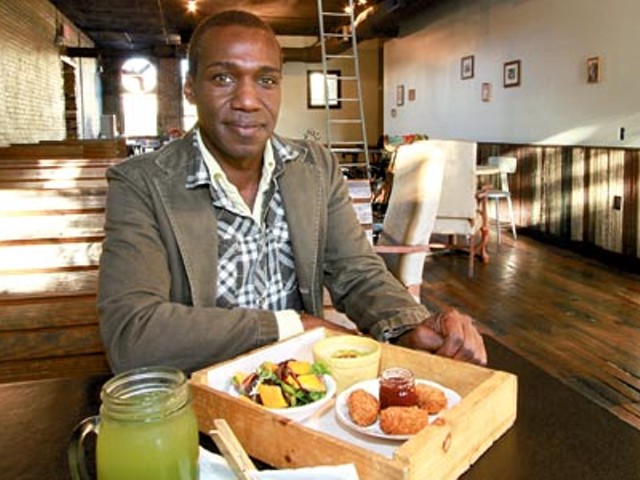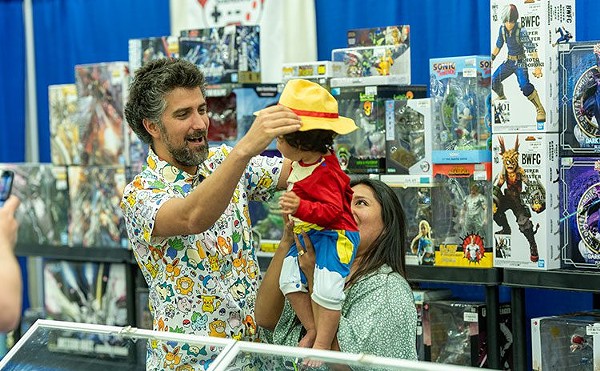What makes a great line cook?
I’ve been on the hunt for a new job this summer, and while I was discussing a potential restaurant gig with a local chef, he mentioned that the duties of the position included working the pantry station for part of the shift. The responsibilities of a pantry station normally include prep and then execution of salads, cold appetizers and/or desserts during service. “That’s fine, I like pantry, and I’m good at it,” I said. “As long as it doesn’t involve the hot line. I’m no line cook.” The chef and I nodded at each other. We both instinctively knew what I meant.
After I got home, I was a little appalled that I’d sold myself short during an interview (stupid!), but I had to admit I’d been honest. So I started to think about what was so obvious — to both me and the chef — about the qualities of a good line cook that we didn’t even have to verbalize it.
There are four kinds of restaurant cooks: naturally gifted line cooks, those who can be trained as decent line cooks, folks who think they’d make a great line cook but are sadly mistaken, and others (like me) who have known since early on they will never make a good line cook. I will never make a good hot line cook because I don’t thrive on the panic and controlled chaos of the “rush” — that portion of service where tickets are shooting out of the printer like water from a fire hose, the servers are manic and the expediter is shouting for stuff you don’t have even half-cooked yet. It’s a true skill to be able to resist the pressure, calmly say, “It’s not done yet!” and still keep your composure. Also, I’m a perfectionist when it comes to plating, and either you’re a total badass at plating under fire or you will fall behind during service, at which point you find yourself “in the weeds” — a phrase all restaurant workers know and dread.
Dallas McGarity, executive chef and partner at Marketplace Restaurant in Theater Square downtown, was recently kind enough to share with me his thoughts about the qualities of a great line cook:
“A good line cook listens and learns every day; he or she is eager to grasp new techniques while embracing the old ones. A good line cook always asks the reasons behind something, works clean and keeps their mise en place stocked. Good line cooks actually enjoy cleaning the kitchen at the end of the night, because they have pride in their stations.
“Good line cooks aren’t afraid to do dishes — hell, most of us started out in the dish room. I know I did! Good line cooks end up becoming good chefs but will always be good line cooks. Most importantly, a good line cook has a lot of passion for food and the industry.”
• • •
What makes a great server?
Servers interact with both the patrons in the dining room and the crew in the back of the house. This is an important distinction — as a cook, I never had to leave the kitchen and talk to customers unless I knew someone on a personal basis, or just wanted to ramble around out front and take my kudos as a pastry chef. Servers have to do physically demanding work while remaining presentably neat and professional. The successful ones have to maintain a charming and cheerful demeanor, and be efficient and capable.
There are two categories of great servers — those who are great in the eyes of management, and those who are great in the eyes of the guests. In an ideal situation, these qualities dovetail perfectly. It’s rare, but when it happens, it’s amazing.
Elizabeth Burgess, restaurant manager at Proof on Main, had this to say about what constitutes service perfection:
“In the restaurant industry, part of what we do is create memorable experiences, and a great server will always be a part of that. A guest may not notice the perfectly polished place setting before them, the steak knife placed on their table prior to the arrival of their entrée, or the fact that their water glass is never empty.
“What that guest will notice, however, is the dirty, spotted silverware in front of them; they will notice the fact that they have to request and wait for a utensil they must have to eat their dinner; and they will notice they are thirsty and have an empty glass. Attention to the most minute details of a guest’s experience is what makes a great server.
“A great server can walk up to a table and within moments know which persona they need to pull out of their back pocket in order to best take care of the guest. Should they be chatty and fun, cool and standoffish, snarky and comedic? It all depends on the individuals they are taking care of at the moment. Ultimately, there are many aspects of being a great server. This is a job everyone has the ‘capacity’ to do, but not all who attempt it should.” (Emphasis mine. High-five, Liz — I think I want a T-shirt with that credo on it.)
Louis Painter, one of Proof’s excellent roster of servers, adds: “Very few people truly respect nor have any clue as to the large breadth of knowledge a server relies upon on a daily basis. When done right, service will appear seamless and effortless. The small things set the best apart: the slipping in of a soup spoon and pulling away of the salad fork, or replacing a butter knife with a steak knife. The folding and replacement of a napkin while a customer steps away from the table. Proper etiquette of serving food from the left while pulling dirty plates from the right; to eloquently open an expensive bottle of wine while giving a detailed description of chef’s multiple specials, or answering menu questions and keeping customers’ wine glasses filled after they order a bottle.
“In all, in what seems to be one of the simplest of jobs (to be able to pull it off elegantly and efficiently), a great server must possess an array of knowledge, skills and, most importantly, patience to be able to excel in this position.”
• • •
What makes a great restaurant menu?
A menu is like a map. It’s like one of those flow charts you see on the Internet: “Are you hungry for seafood? Yes? Then order the branzino. No? Then order the pork roast.” But it’s so much more. A menu represents a chef, the restaurant, the desires of its target audience. Hopefully it represents an acceptable price point for its guests and also a repertoire its servers can memorize, internalize and convey competently to the diners.
I worked for a manager not so long ago who insisted on elaborate, overblown menu descriptions such as “farm-fresh green beans sautéed with garlic, thyme, sea salt and olive oil” (I mean, they’d better be fresh — does someone need props for using fresh veggies rather than not-so-fresh?) and “potatoes roasted to a golden brown perfection” and “drenched in a savory burgundy sauce with parsley-buttered linguine.” Modern menu verbiage has been trending for a while now toward a stark list of the basic ingredients of a plate, leaving it to the server to further describe the dish’s preparation and garnishes if and when asked to. Like so: Brook Trout — asparagus, fondant potatoes, bone marrow hollandaise. I’m a pretty big fan of this style of menu writing. It’s simple and easy to understand, and it’s not burdened with all the unnecessary frippery of overwrought minutiae. Good food will speak for itself in the end, anyway, and details can and should be accessible by asking your server, if your curiosity so demands.
John Castro, executive chef of Winston’s Restaurant at Sullivan University, provided me with a list of his essential elements of writing — and implementing — a great menu. Some highlights:
“Know your audience, but don’t be scared to be playful. Don’t let your ego drive your menu — just because you like it doesn’t mean it will sell. Know your staff and what they are capable of producing well. Identify menu trends that fit your brand. Source products responsibly, but make sure you can afford your goal.
“When updating a classic or standard, make sure it still represents the original. Don’t add ingredients when the dish doesn’t need it; cook with restraint and understand the base of the dish first — then add as you see fit.”
• • •
What makes a great chef?
The word “chef” has a long and storied history. Of French origin, it means “head” or “boss.” I find it amusing that Google tells us the informal verb usage is “cheffing” and then gives this example sentence: When they finish cheffing, they gather themselves together and they drink their owners’ best wines. Yeah, they do. I’ve been there when that was happening — usually the owner is the one opening the bottles and pouring the glasses.
I’m afraid the modern American concept of “chef” has been permanently skewed toward chef characters in the movie “Ratatouille” — a movie I love but one that is less than realistic. Good chefs do not sit in their offices all day, plotting culinary get-rich-quick schemes and previewing flashy advertising. They are not oblivious to what’s going on in their kitchen. They may not peel potatoes (or, they may — if that’s what needs to be done next), but you can bet they are out there in the trenches, tasting sauces, giving mini-lessons on how to clean squid and checking on the progress of the day’s prep. They are keeping a watchful eye on a prep cook who probably needs to be promoted to the hot line. They are fielding a dozen requests a week for charity donations and media appearances. It’s not all snipping rosemary in the garden out back with titanium herb shears. It’s about scheduling that next exhaust hood cleaning and making sure the ware-washing machine gets repaired immediately rather than later, because you don’t want to lose that fabulously motivated dishwasher you hired last month.
Joe Castro — yes, John Castro’s brother — the executive chef-in-residence at GE’s Monogram Experience Center at Appliance Park (and veteran of the English Grill at the Brown Hotel), sent me this missive about what qualities are embodied in a great chef:
“I believe the pounding you take in a well-run kitchen gives you the personality to see you through almost anything. A great chef has loyalty to his crew and a sense of discovery founded with sound cooking skills. If you have the experience, people will follow; it’s fun to pass on what others gave you, laced with your own creativity. A desire to learn, train and lead are key elements to any profession. And in this media-driven world, don’t forget that your food does your talking.”
• • •
What elements make up a near-perfect dining experience?
If you think back to your last positive evening spent dining out, there were probably a lot of facets that came together to make it memorable. Your hair looked great, you snagged a reservation at a place you truly love or a place you’d been dying to try, the taxi showed up exactly on schedule. When you arrived at the restaurant, the ambience was perfectly suited to your mood; there were enough other patrons there that you felt validated in your good taste, but not so many that you were jostled and impatient to be seen to. The server acknowledged you in a timely manner after you were seated, so you didn’t have to spend that awkward 10 minutes wondering if anyone knew you and your date were on deck for service. Menus and cocktails were brought promptly. You were made to feel like you were the most important guest in the restaurant.
Tim Laird, chief entertainment officer of Brown-Forman, let me know in no uncertain terms what he considers to be the essential elements of a great dining experience.
“Great service starts when you enter the establishment and does not end until you walk out the door. What matters is how you are greeted through to the final signing of the check.
“There are a couple of quintessential ingredients that take the dining experience from ordinary to spectacular. The first ingredient is not the food, it is the service. Great and consistent service is the hardest part for the restaurateur to master. In fact, if you over-deliver on service, everything else during the dining occasion will seem better.
“The second ingredient to the dining experience is cleanliness. There is no excuse for any restaurateur not to deliver on this aspect.
“Finally, food and beverages should be delivered — as promised — consistently. This means the chef and the bar manager have properly trained everyone on what is offered on the menu. Consistency is the key to food service. I realize this is a challenge, but it should be a focus. No matter what is being served, it should be consistent from visit to visit.”
He’s right, of course. What’s worse than dragging your friends to your favorite new spot only to discover that tonight’s empanadas are a pale, flabby version of the crispy, sizzle-y delightful ones you fell in love with last weekend?
• • •
So take heed, chefs, managers and owners: If you’ve got an intriguing menu, backed up solidly by a loyal cooking crew and a couple of stellar servers, you can hardly go wrong. As for the rest of you — the dining public — it sounds easy, doesn’t it?
Actually, it’s not even remotely easy. There is an army of people who juggle the saucing spoons, sauté pans, lemon wheels and reservation books required to make you feel welcome and pampered in our places of business. That linen napkin didn’t fold itself into a bird of paradise all alone. If it had, we’d have put it to work polishing champagne flutes earlier this afternoon.
Marsha Lynch has worked at many Louisville independent restaurants including Limestone, Jack Fry’s, Jarfi’s, L&N Wine Bar and Bistro, and Café Lou Lou.






